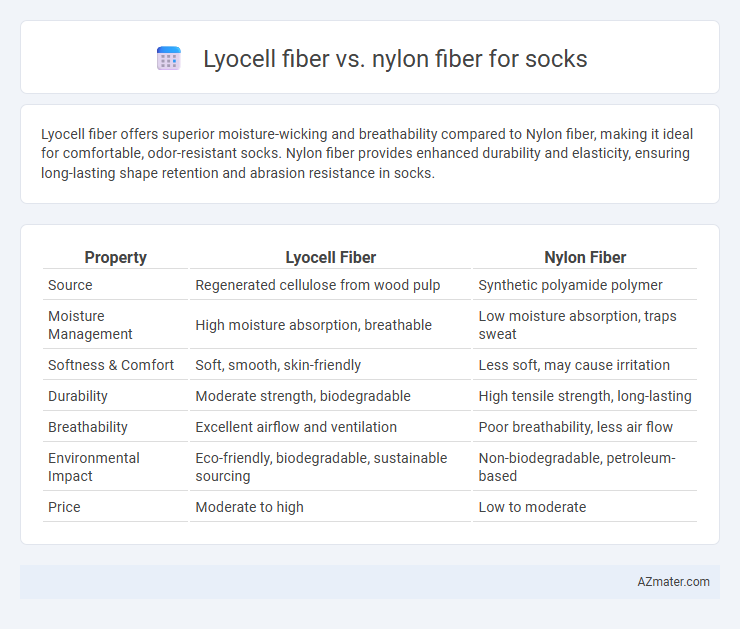Lyocell fiber offers superior moisture-wicking and breathability compared to Nylon fiber, making it ideal for comfortable, odor-resistant socks. Nylon fiber provides enhanced durability and elasticity, ensuring long-lasting shape retention and abrasion resistance in socks.
Table of Comparison
| Property | Lyocell Fiber | Nylon Fiber |
|---|---|---|
| Source | Regenerated cellulose from wood pulp | Synthetic polyamide polymer |
| Moisture Management | High moisture absorption, breathable | Low moisture absorption, traps sweat |
| Softness & Comfort | Soft, smooth, skin-friendly | Less soft, may cause irritation |
| Durability | Moderate strength, biodegradable | High tensile strength, long-lasting |
| Breathability | Excellent airflow and ventilation | Poor breathability, less air flow |
| Environmental Impact | Eco-friendly, biodegradable, sustainable sourcing | Non-biodegradable, petroleum-based |
| Price | Moderate to high | Low to moderate |
Introduction to Lyocell and Nylon Fibers
Lyocell fiber, derived from sustainable wood pulp using a closed-loop process, offers exceptional breathability, moisture-wicking properties, and biodegradability, making it ideal for eco-friendly socks. Nylon fiber, a synthetic polymer known for its high tensile strength, elasticity, and durability, provides resistant and long-lasting performance in sock manufacturing. Choosing between Lyocell and Nylon fibers depends on prioritizing natural comfort and environmental benefits versus toughness and stretch in sock applications.
Environmental Impact: Lyocell vs Nylon
Lyocell fiber, derived from sustainably sourced wood pulp using a closed-loop process, significantly reduces water usage and chemical waste compared to nylon fiber, which is petroleum-based and contributes to microplastic pollution. The biodegradability of lyocell fibers ensures minimal environmental footprint at the end of the sock's lifecycle, whereas nylon persists in landfills and oceans for decades. Choosing lyocell socks supports lower carbon emissions and promotes circular fashion, making them an eco-friendly alternative to conventional nylon options.
Comfort and Softness Comparison
Lyocell fiber in socks offers superior moisture-wicking properties and breathability compared to nylon fiber, enhancing overall comfort by keeping feet dry and cool. Its natural cellulose composition results in a softer, smoother texture that reduces irritation and friction against the skin, promoting a gentle feel throughout extended wear. Nylon fiber, while durable and elastic, tends to trap heat and moisture, making it less comfortable and softer than Lyocell in sock applications.
Moisture Management and Breathability
Lyocell fiber excels in moisture management by efficiently wicking sweat away from the skin, promoting faster evaporation and keeping feet dry during prolonged wear. Its natural breathability allows for superior airflow, reducing heat buildup and enhancing overall comfort in socks. In contrast, nylon fiber, while durable and quick-drying, tends to retain moisture longer and offers less breathability, which can result in increased foot perspiration and odor over time.
Durability and Longevity of Socks
Lyocell fiber offers excellent moisture-wicking properties and breathability, making socks comfortable and less prone to odor buildup, but it is generally less durable than nylon fibers. Nylon fibers provide superior strength, abrasion resistance, and elasticity, significantly enhancing the durability and longevity of socks under frequent wear and washing. Combining Lyocell with nylon can optimize both comfort and durability, extending the overall lifespan of the socks.
Odor Resistance and Hygiene
Lyocell fiber exhibits superior odor resistance and hygiene properties compared to nylon fiber due to its natural moisture-wicking abilities and antimicrobial characteristics, which inhibit bacterial growth that causes odor. Nylon, while durable and stretchy, tends to retain moisture and create a breeding ground for odor-causing bacteria, leading to less effective odor control. Choosing Lyocell fibers in socks enhances freshness and comfort, especially during extended wear or physical activities.
Skin Sensitivity and Allergen Risks
Lyocell fiber is highly suitable for socks worn on sensitive skin due to its natural, breathable, and hypoallergenic properties that reduce irritation and allergen risks. Nylon fiber, while durable and moisture-wicking, can sometimes cause discomfort or allergic reactions in individuals with sensitive skin due to its synthetic nature. Choosing Lyocell fiber socks helps minimize skin sensitivity issues and promotes healthier skin contact compared to nylon.
Color Retention and Aesthetic Appeal
Lyocell fiber exhibits excellent color retention due to its smooth surface and high dye affinity, resulting in vibrant and long-lasting sock colors compared to Nylon fiber, which tends to fade faster under repeated washing. The natural sheen and soft texture of Lyocell enhance the aesthetic appeal of socks, providing a premium look and comfortable feel, whereas Nylon's synthetic gloss can sometimes appear less natural and wear down faster. For socks demanding enduring color vibrancy and sophisticated appearance, Lyocell offers superior performance over Nylon.
Cost-Effectiveness and Affordability
Lyocell fiber offers superior moisture-wicking and breathability at a moderate cost, making it an affordable option for eco-conscious sock manufacturers. Nylon fiber provides exceptional durability and stretchability at a lower price point, resulting in highly cost-effective socks for mass production. Evaluating production scale and target market preferences is crucial to determining the best fiber choice for maximizing price-performance balance in sock manufacturing.
Best Use Cases: Choosing the Right Fiber for Your Socks
Lyocell fiber is highly breathable, moisture-wicking, and biodegradable, making it ideal for socks used in activewear or warm climates where comfort and sustainability are priorities. Nylon fiber offers superior durability, elasticity, and abrasion resistance, making it the best choice for performance socks, hiking, and heavy-duty use where longevity and fit retention are critical. Selecting the right fiber depends on whether comfort and eco-friendliness or durability and stretchability are your primary needs for sock performance.

Infographic: Lyocell fiber vs Nylon fiber for Socks
 azmater.com
azmater.com